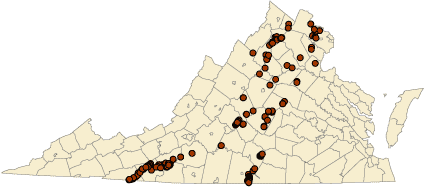
Copper is a reddish, relatively abundant, easily-worked metal with a bright metallic luster. Its chemical symbol is Cu. Copper occurs as a native metal and as compounds (frequently of sulfur) that are easily smelted. It is a good conductor of heat and electricity, and its main uses are in electrical wire, plumbing, roofing, coins, and jewelry. Copper is commonly used as an alloy (combined with other metals) with tin to make bronze and with zinc to make brass.
Year of first production in Virginia: mid- to late-1700s
Location of first production in Virginia: probably Mecklenburg County
Year of last production in Virginia: 1947
Location of last production in Virginia: Toncrae Mine, Floyd County
Total cumulative production in Virginia: 2,363,563 pounds (1905-1947 only)
Current annual production in Virginia: none
In Virginia, the deposits where copper has been found appear to be originally formed from warm metal-rich saline brines or submarine hot springs that flowed along fractures associated with rift systems or island arcs. These deposits were subsequently deformed by thrusting and masked by plate closing tectonism. Copper has been widely mined in the Piedmont and Blue Ridge provinces, and locally in the Valley and Ridge Province.
In the Piedmont province, copper has been found in massive sulfide lenses in the Cambrian Chopawamsic Formation, which crops out for 110 miles northeast-southwest across central Virginia, and includes Louisa and Buckingham counties; as copper sulfides in quartz veins in the Cambrian Aaron Formation in Halifax and Charlotte counties; as copper sulfides and secondary copper minerals in Upper Triassic sedimentary rocks in the Culpeper basin in Culpeper, Fairfax, Fauquier, Loudoun, Orange, and Prince William counties; and as disseminated copper minerals in the Precambrian Alligator Back Formation in Amherst, Appomattox, Campbell, Bedford, and Pittsylvania counties. It is often associated with lead and zinc massive sulfide deposits, and with quartz veins in metavolcanic rocks.
In the Blue Ridge Province, copper has been found in massive-sulfide zinc- and copper-bearing pyrrhotite deposits in the Late Precambrian Ashe Formation in Carroll, Grayson, and Floyd counties, as copper minerals in fractures in the Late Precambrian Catoctin Formation in Clarke, Fauquier, Loudoun, Page, Rappahannock, and Warren counties, and associated with granitoid plutons in Rockbridge, Amherst, Nelson, and Rappahannock counties.
In the Valley and Ridge Province, copper has been found in the Cambrian Shady Dolomite in Wythe, Smyth, Pulaski, and Montgomery counties, and in the Ordovician Beekmantown Formation in Augusta, Rockingham, and Shenandoah counties.
Selected References:
Luttrell, G. W., 1966, Base- and precious-metal and related ore deposits of Virginia: Virginia Division of Mineral Resources Mineral Resources Report 7, 167 p.
Sweet, P. C., Good, R. S., Lovett, J. A., Campbell, E. V. M., Wilkes, G. P., and Meyers, L. L., 1989, Copper, lead, and zinc resources in Virginia: Virginia Division of Mineral Resources Publication 93, 185 p.
Watson, T. L., 1907, Mineral Resources of Virginia: Lynchburg, Virginia, Jamestown Exposition Commission, 618 p.
(available as Virginia Division of Mineral Resources, 2003, Digital reprint of T. L. Watson’s 1907 Mineral resources of Virginia: Virginia Division of Mineral Resources Publication 175, [CD-ROM; 2003, September 1].
